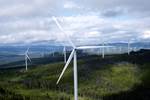TPI, University of Texas participate in wind blade cure optimization project
Physics-informed machine learning algorithms will be applied to simulate and optimize composite wind blade curing in an effort to advance smart composites manufacturing in industry.
RFID-based temperature and curing sensor implemented during the project. Source | TPI Composites, University of Texas
On Aug. 14, TPI Composites Inc. (TPI, Scottsdale, Ariz., U.S.) announced its participation with the University of Texas at Dallas to apply physics-informed machine learning (ML) algorithms to simulate and optimize the composite wind blade curing process through multi-zone temperature control. It is reported that this will solve a current technological gap by developing a smart “digital twin” that optimizes the curing process in wind blade manufacturing. Funded by the Office of Energy Efficiency & Renewable Energy, this project will accelerate the transition of research on ML-based modeling tools in academia to real industrial applications.
The digital twin will take inputs like spatial and temporal characteristics of the process and material properties of the composite components to guide the manufacturing process by providing the optimal spatiotemporal temperature profiles needed to achieve the design’s target mechanical properties. Real-time data from sensors are collected as the blade manufacturing process advances. Thermal loads in multiple heating zones are then adjusted based off optimal cure trajectory identified by the surrogate digital twin in the background.
“The application of statistical physics-informed AI models bridges the gap between deterministic multiphysics simulations and kinetics of cure as happening on the shop floor,” Dr. Shaghayegh Rezazadeh, TPI lead engineer, says. “This process leverages different heating zones integrated in TPI molds to achieve the desired mechanical properties while optimizing the cure cycle time to ensure consistent quality and enhanced productivity for the blades manufactured by TPI. The data collection from sensors enables reinforced learning and model refinement to improve the accuracy of the models and adaptation to environmental conditions and variabilities in labor-intensive manufacturing processes.”
Dr. Dong Qian, the principal investigator on the project, adds that this collaborative research will lay a foundation for smart composite manufacturing and provide a significant competitive advantage for industries adopting these technologies, in terms of cost savings and performance improvement.
Related Content
-
Pultrusion: The basics
A primer describing what pultrusion is, its advantages and disadvantages, and typical applications.
-
Sulapac introduces Sulapac Flow 1.7 to replace PLA, ABS and PP in FDM, FGF
Available as filament and granules for extrusion, new wood composite matches properties yet is compostable, eliminates microplastics and reduces carbon footprint.
-
Jeep all-composite roof receivers achieve steel performance at low mass
Ultrashort carbon fiber/PPA replaces steel on rooftop brackets to hold Jeep soft tops, hardtops.













